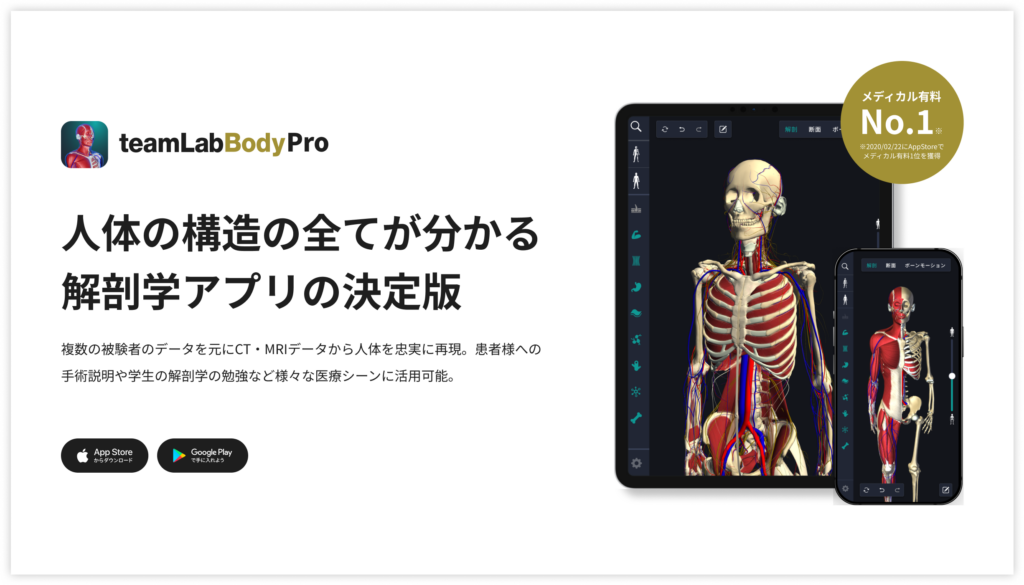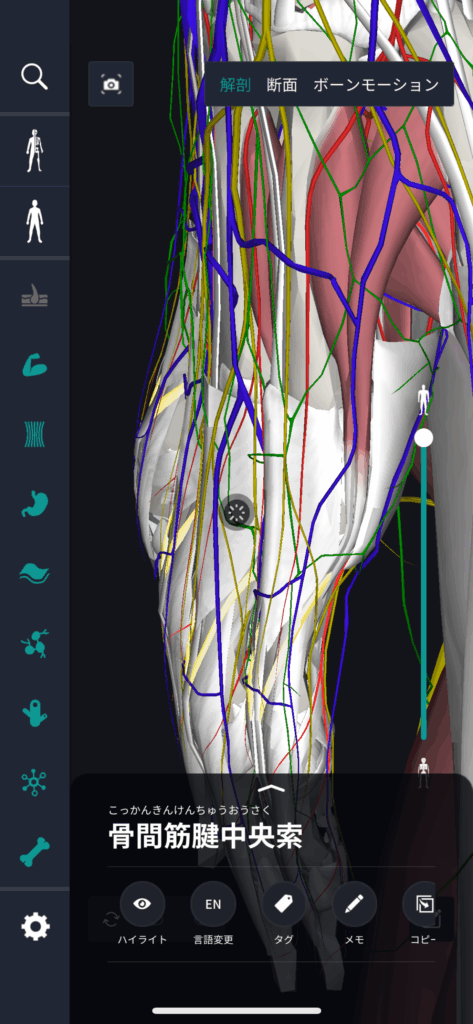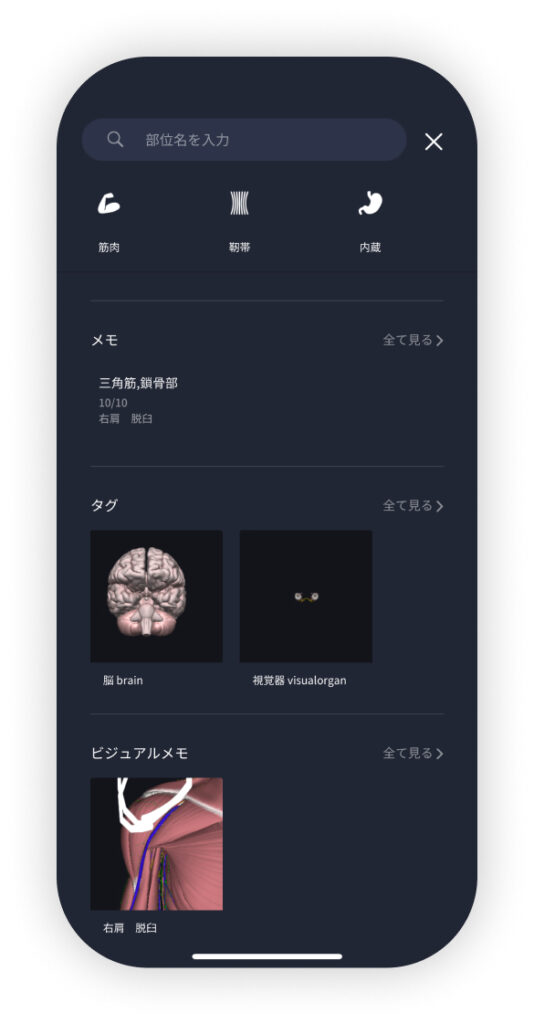beginning
In this article, I will explain effective study methods, starting with knowledge of specialized parts in human anatomy.
In human anatomy, it is necessary not only to memorize the names of various organs, muscles, and bones, but also to remember where they are located in the body. Therefore, it is necessary to learn as efficiently as possible.
I hope you can read this article and use the app to deepen your understanding even a little bit.
Now, I will explain the contents of the “central interosseous tendon cord” and how to study human anatomy.
teamLab Body Pro Free Download
A 3D anatomy app that shows all the structures of the human body
Download teamLab Body Pro here!

What is the central cord of interosseous tendons?
In the anatomy application, you can view a selection of anatomy 3D models. In this model, there are various observation methods such as surfaces, cross-sections, and nervous systems. This time, I'll explain using an anatomy application.
About the central cord of interosseous tendons

The central interosseous tendon cord is an element that mainly plays an important role in the anatomy of the hands and feet. This cord is mainly associated with palmar interosseous muscles and dorsal interosseous muscles. In hand anatomy, the central interosseous tendon cord contributes to finger extension and supports the precise movement of each finger. They are part of the tendon that connects the middle and end bones, and allows fine movement and force regulation. The central cord cooperates with other fibrous structures, has a role in balancing finger extension and flexion, and contributes to keeping finger movements smooth. This structure is usually located along the direction of the flexor tendon and works in collaboration with aponeurosis and tendon ligaments. As for the foot, the central interosseous tendon cord has a more complex structure and is particularly involved in walking and maintaining balance. The interosseous muscles of the foot are located between each toe from the 1st toe to the 5th toe and support the stability and strength of each toe. The central cord affects the coordination of movements of the pterus (thumb) and little toe (little finger), and when viewed from an external perspective, it plays a role in maintaining the overall arch structure of the foot along with other short muscles and long muscle groups. Thus, the central interosseous tendon cord is an important structure in hand and foot function, and particularly affects fine motor coordination and force transmission. Their anatomical understanding provides a basis for understanding how these actions are achieved.
Study points
Location and structure of the central cord of interosseous tendons
The central interosseous tendon cord is an important element with a specific location and structure in hand and foot anatomy. First, let's talk about the central interosseous tendon cord of the hand, and these are mainly located between the metacarpal bones of the hand, that is, between each finger. It is associated with the interosseous muscles on the palmar side and dorsal side of the hand and supports finger movement in different positions. The cords on the palm side help the fingers to flex and allow fine movement. The dorsal cord promotes finger extension and backward movement, and is important during lifting and pushing movements. Meanwhile, the median interosseous tendon cord in the foot is usually found between each toe and works particularly together with the plantar fascia. These cords generally span muscle groups on the back and bottom of the foot, and play a role in maintaining foot stability. Especially when walking, etc., the interosseous muscles on the plantar side contribute to flexion of the toes and body weight support, and the muscles on the anterior side strengthen the extension of the toes. As a structure, the central cord of the interosseous tendon of the hand and foot consists of flexible and strong fibers as part of the tendon, and is formed by gathering many fiber bundles. These bundles bind tightly to the bones and joints of the fingers and toes, creating a structure that distributes the force needed to perform movements more efficiently and accurately. This arrangement is both durable and flexible enough to withstand frequent use, and supports basic movements in everyday life.
The role and function of the central cord of interosseous tendons
The central interosseous tendon cord plays an important role in supporting hand and foot function. First, its role in the hand is as follows. The central interosseous tendon cord contributes to achieving precise finger movement. Specifically, it adjusts the flexion and extension of the fingers and helps with tasks that require detailed operation or pressure. The central cable increases the stability of movements such as lifting, pushing, and pulling, and enables clever finger control when holding objects. The role of the central interosseous tendon cord in the foot is mainly related to walking and maintaining posture. It works with plantar fascia and works to maintain balance during walking while supporting body weight. In particular, as a function that supports the arch of the foot, it absorbs shock and contributes to the efficient distribution of ground reaction force. Thus, the central interosseous tendon cord provides flexibility that can handle dynamic movements such as jumping and running while maintaining foot stability. Also, the central interosseous tendon cord enhances movement accuracy through cooperation with nerves. It controls proper muscle contraction and relaxation, and contributes to suppressing incorrect movements and forming correct movement patterns. This reduces the risk of damage and provides a foundation for sustainable efficient operation.
English notation for central cord of interosseous tendon
The English notation for the central cord of an interosseous tendon is “central slip of the interosseous tendon.” To better understand this expression, we will focus on its structure. First, “central” means “central” or “central” and indicates the middle or main part of a structure in an anatomical context. This is an important expression referring to how the tendons of the interosseous muscles are arranged. “Slip” is a technical term indicating “the long and narrow part of a tendon.” This usually indicates a portion of a specific tendon or muscle when multiple structures intersect. Specifically, it represents a form formed when a specific muscle connects to bone. “Interosseous” means “between bones,” and indicates muscles and structures related to the interosseous muscles of the hands and feet and located between bones parallel in the longitudinal direction. Finally, “Tendon” means “tendon,” and forms the part where muscle endings attach to bone. Thus, the contractile force of the muscles is transferred to the skeleton and movement is possible. By connecting these words, the anatomical function of the central interosseous tendon cord is clearly understood. This term is an important element in academic communication and research to help understand specific structures.
How to study human anatomy
I will explain specific study methods using human anatomy applications.
Check your past learning history and practice repeatedly
Here are the steps to check your anatomy learning history and practice iteratively effectively.
1. Check your learning history in the app
Reviewing your learning history with the application is an important step in effectively advancing anatomy learning. First, launch the app and go to the learning history section from the main menu. Many anatomy apps are designed to show your progress in the form of graphs and lists, so you can visually check which parts you've learned about and how much time you've spent.
By using this data, you can understand which areas you have strengths in and where you need to spend more time and effort. We also recommend using a dedicated tag or notebook function to mark areas you are particularly weak at or where you need to relearn. Regularly checking your learning history and looking back on past learning content will lead to efficient review and deepening understanding.
2.Make a plan for iterative learning
Making an efficient repetitive learning plan based on learning history is extremely effective in promoting knowledge retention. First, identify weak points and areas where you need to relearn. Next, arrange these study items into a weekly or monthly calendar and create a specific study schedule. By proceeding in a planned manner, you can learn each part evenly and avoid packing in a large amount of information at once.
Using a task management app or digital calendar to set study reminders is effective. Also, it's important to have the flexibility to regularly review progress and revise plans as needed. By having goals and proceeding with your studies in a planned manner, you can efficiently acquire anatomical knowledge.
3.Use 3D features to learn visually
By utilizing the 3D function, learning anatomy is easier to understand visually. The 3D model shows the structure of the human body three-dimensionally, and each part can be observed in detail. This makes it possible to intuitively grasp positional relationships between deep muscles and organs that are difficult to capture in a planar view. For example, you can learn even the smallest details by rotating specific muscles and bones and zooming in and out.
Also, there are many apps that have the function of displaying cross-sectional views of each part using a 3D model, which is useful for deepening understanding of internal structures. This diversity of visual information helps with memory retention and improves immediate responsiveness in tests and practice situations. By utilizing the 3D function and learning visually, you can learn anatomy knowledge more deeply and efficiently.
Use the memo function concretely

Make notes so you don't forget the things and points you've noticed while studying. The memo function can be used for different purposes, such as inputting text, saving images, and writing memos. Tag your notes to make them easier to review later.
Test your learning regularly in the form of quizzes
Regularly testing what you've learned in a quiz format is a very effective way to anchor your anatomy knowledge. Quiz-style tests help you objectively grasp your level of understanding and areas you lack while repeating knowledge.
For example, by using a learning app to conduct quizzes every specific period, you can reconfirm what you've learned and strengthen your memory. There are a wide range of quiz formats, such as multiple choice questions, fill-in-the-blank questions, and short answer questions, and each helps understanding from a different angle and develops the ability to utilize various types of knowledge.
Get feedback
If possible, get feedback from other learners and experts. It helps you find your own gaps in understanding and areas for improvement. You can also keep yourself motivated to learn by regularly testing yourself. Feeling a sense of accomplishment and progress increases motivation for continuous learning.
summary
This time, I explained how to study the “central interosseous tendon cord” using an application!
Thank you for reading this far.
I would be happy if reading this article helped you learn about anatomy.
Learning is a long, never-ending journey, but I sincerely wish you all the best. Let's continue to study together and work hard for the national exam!
Please look forward to the next blog.




